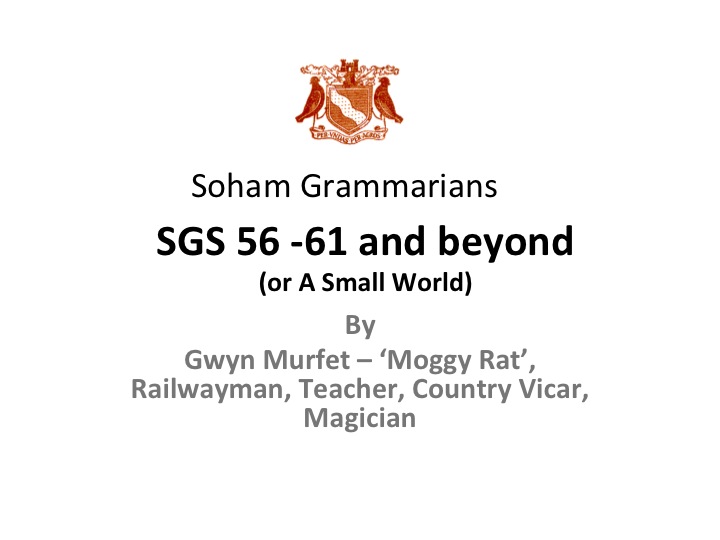
This page contains some large images so please allow time for it to
download if you have a slow connection
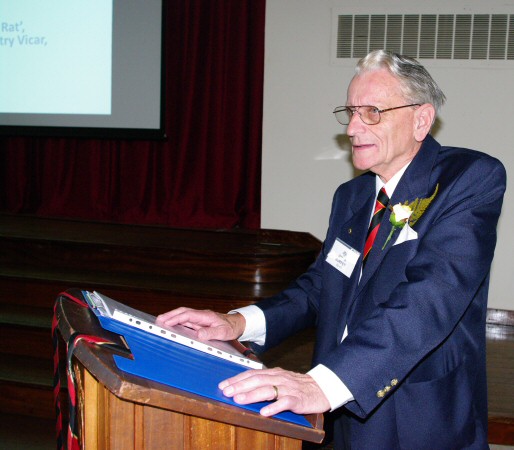
Our speaker decorated the lectern with old school ties
I have given the talk an alternative title : “It’s a small world”.
When I arrived 2 years ago, and donned my name tag, an older chap gazed at it intently. I realised he had left before I came in 1956, so was surprised when he said “Ah ... Gwyn Murfet. You’re the boy who let the water out of the heavy roller.” I said, “How did you know that?” He replied “You told me in the hearse going to the crematorium”
I shall not speak much of my time here, as it is all on the Scrapbook page of the Soham Grammarians' web site in Memoirs of a Moggy Rat - Moggy Rat being the derogatory term given to those of us who had passed the 11 plus, by those who had to remain at the Shade School, this being in the days before the Village College.
When Frank Haslam asked me to give this talk, he said “talk of your time at SGS and since, and the famous people you havemet” - could be clutching at straws I thought!
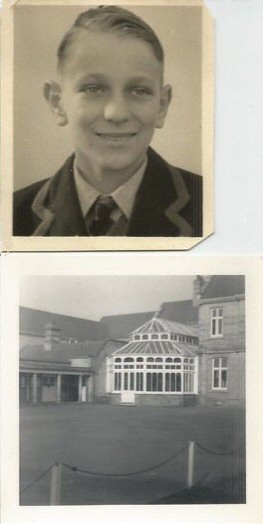
At the bottom of this page, we find William Murfet who married Hephzibah Owers in 1851. Hephzibah?
Isaiah 62 v4 "Thou shalt no more be termed Forsaken; neither shall thy land any more be termed Desolate: but thou shalt be called Hephzibah, and thy land Beulah: for the Lord delighteth in thee, and thy land shall be married."
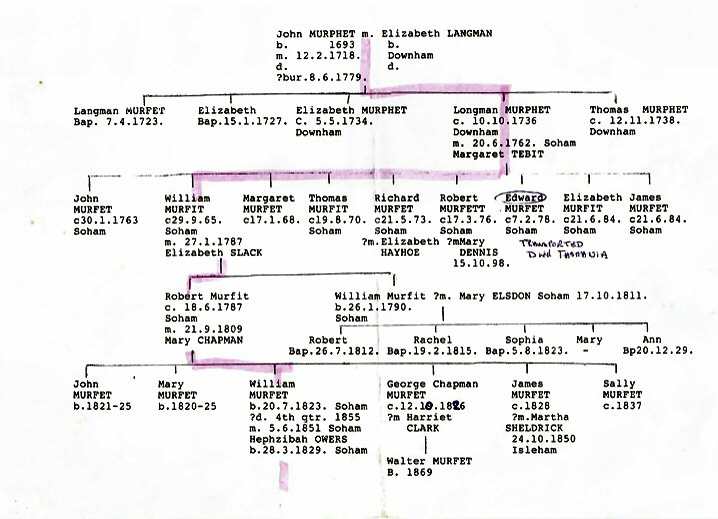
Hephzibah’s father was an organ builder and cabinet maker here in Soham, and we still have a small glass cabinet made by him in the early C19. Between Summerscales cycle shop and the Milky Way there is a row of terraced houses called “Owers Terrace” - same Owers!
William and Hephzibah had a son, Robert, who married Rebecca Whymer in 1873.Robert was the guy who started Murfet’s Bakers in Red Lion Sq, which we will return to.
|
They had 3 sons. Starting with the youngest first. Herbert Victor left Soham and became a pub landlord in Hedgerley. Albert Edward took over the bake house when Robert died in 1915. You may remember the old electric delivery van in the 1950/60’s “A E Murfet and Sons”. His sons Bert and Bob ran the business helped by my father. The eldest son, Frederick John, always known as Jack, was my grandfather. We might note my father’s youngest brother “Doug”, who will crop up later. |
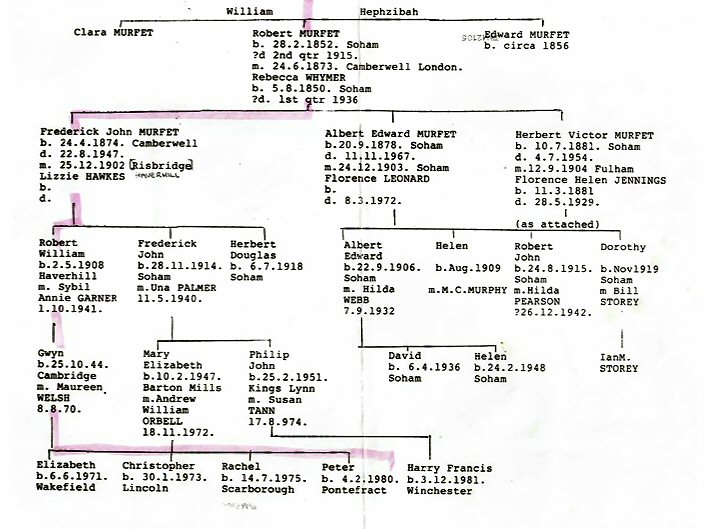 |
| Jack moved to Haverhill where he trained as a butcher,
working for Jarvis at 22, High St, Haverhill. Jack is the
young man in the centre.
As far as I can tell, the shop stood where Poundland now stands. He fell madly in love with a young lady named Lizzie Hawkes; they married and returned to Soham just after my father’s birth in 1908. |
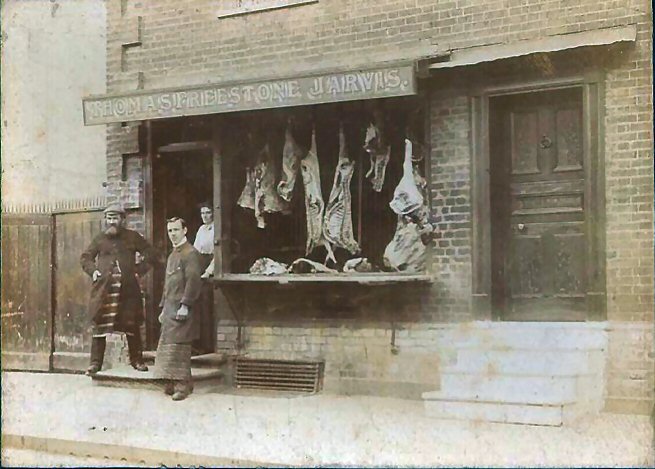 |
|
Looking at this early 1920s photo of Red Lion Sq we note: the Baptist Chapel, Murfet’s Shop, the bakehouse, Jack’s butcher’s shop, and the Rendezvous Club. At SGS, I always went home for lunch, and as I went back to school, father coming in would say "I've just seen that Latin master of yours coming out of the Rendezvous". No wonder Latin with Mr Saunders was more relaxed in the afternoon than in the morning! |
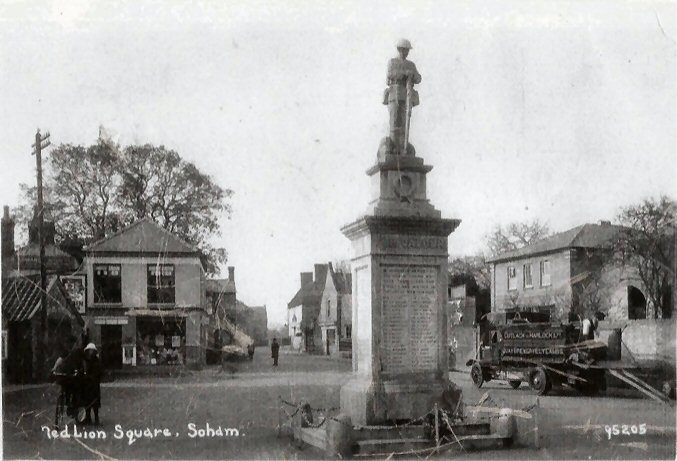 |
| Jack and Lizzie moved into what is now 45 The Butts, and
here we see my grandmother Lizzie, not all that long before
she died.
It was a typical Tebbitt’s rented house. No running water until the sewerage was installed in my 4th year here at SGS. No electricity right up to us moving out in 1965; father wouldn’t have it on the grounds “you can’t smell it when it escapes”!! Gas lights were only installed in the back bedrooms when I started at Grammar School, and were probably the last domestic gas lights installed anywhere in Soham. |
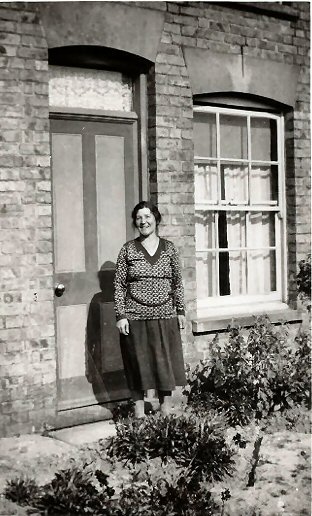 |
Father was a keen cyclist, and once holidays were introduced in the 1930s, hestarted cycling to Wales, leaving Soham at 7am, and checking in to a B&B in Welshpool at 7pm. These holidays are why I have a welsh Christian name. Returning from Wales the first time, he entered a pub near Shrewsbury. On asking where he came from, the landlord said he only knew one person in Soham - Jack Murfet the butcher! It’s a small world!
| Lizzie’s father, Billy Hawkes, was called out of retirement
in 1935, being the last hand silk weaver in Suffolk, to weave
a special bookmark used by King George V at his Silver Jubilee
service.
He wove a few extra inches for his children. |
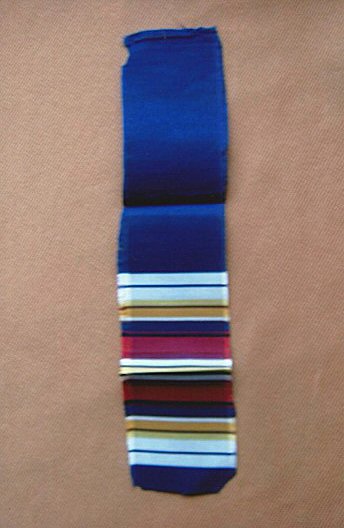 |
| Soham was rocked by the explosion at the station in June
1944.
This is a tapestry I designed and my wife worked for the 50th anniversary in 1994. After the anniversary service in church, it hung in The Village College during a cheese and wine evening. A lady came up to me and said “that window was my bedroom” - she was Pat Oliver daughter of the station master. She and her brother were only saved by the wardrobe being pushed over them by the blast as the roof and walls collapsed around them. A book has been published this year entitled Trains at War which gives good account of the incident, but not a single photo. |
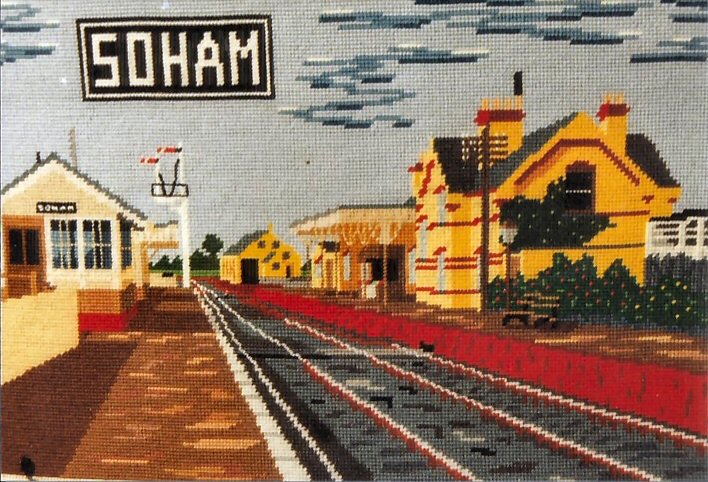 |
| Here is the engine No. WD7337, where it came to rest.
Not surprising that Jim Nightall, the fireman was killed instantly, but the survival of Ben Gimbert, the driver, defies all logic. Incredibly, the engine was repaired, and ran for another 20 years on the Longmoor Military Railway in Hampshire running as Sir Guy Williams. |
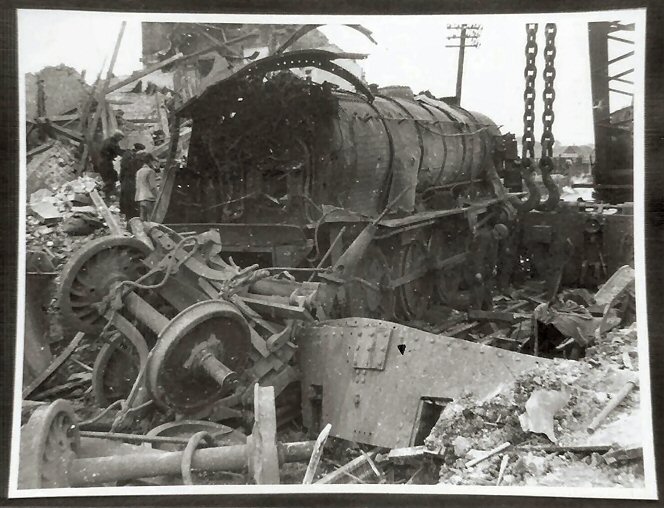 |
| The explosion created a crater 66 feet in diameter and 15
feet deep.
Pat Oliver said the saddest thing for them as children was seeing the soldiers bulldoze their toys, books, clothes - in fact all their possessions - into the hole, where they remain to this day. |
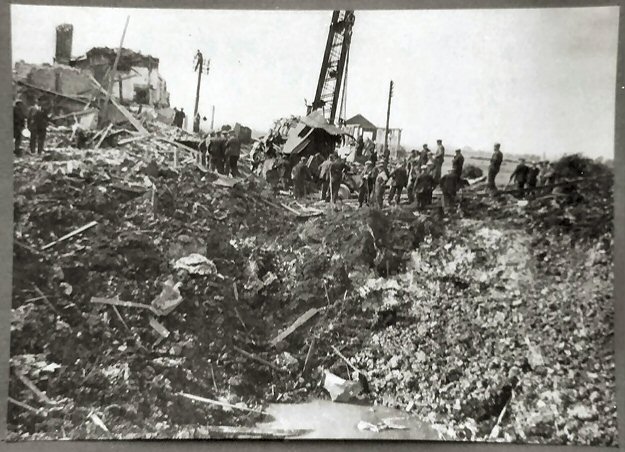
|
| Not many people have seen this photo: it is 8.30pm the same
day.
The crater has been filled, the track re-laid and a linesman is attempting to make contact with Fordham and Barway Siding. The first trains ran a couple of hours later. Eat your heart out Network Rail! |
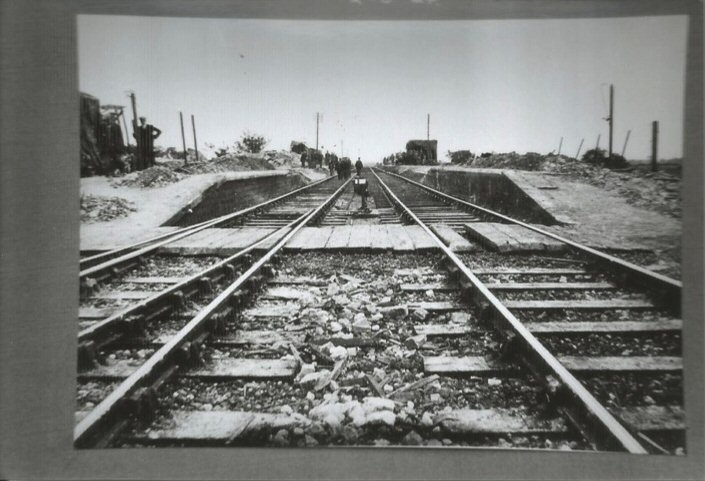 |
| What we didn’t know, was that the explosion had cracked the
gable end of the house.
On Sunday 16th March 1947, as the disastrous Fen floods were getting under way, there was a terrific storm and the end of the house blew out. This photo of number 45, now with a porch. taken in 2006, shows the gable end in red brick - the rest of the house is in yellow. |
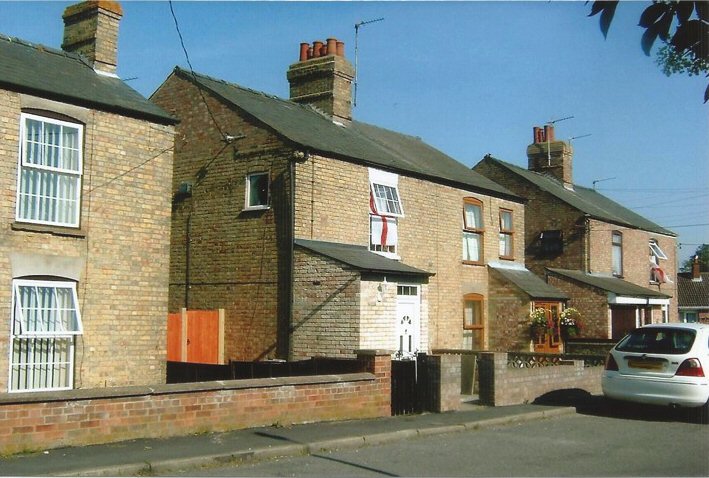 |
| At this time, our next door neighbours were the Lelantern
family. Both sons, Alan and John were at the Grammar School,
and in 1948 sold my mother a school draw ticket.
I won this coffee table which is still in daily use, and is a credit to the lad here who made it. |
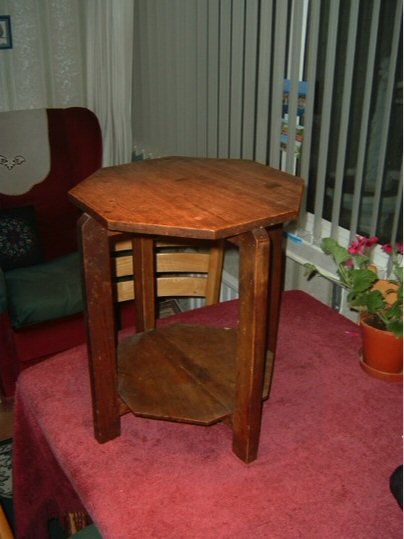 |
In September 1949, Ivan and I started Clay St. Infants, where our teacher was Miss Dollymore. On my first day at SGS, I learnt that she had been brought to Soham everyday by Mr Taylor. It’s a small world.
| September 1951, saw a start at the Shade School.
Now I am NOT modelling Soham, but I wanted items from my past on the 24 foot backscene. I hadn’t touched an artist’s paint brush since the 4th Form, so I am quite pleased with this. |
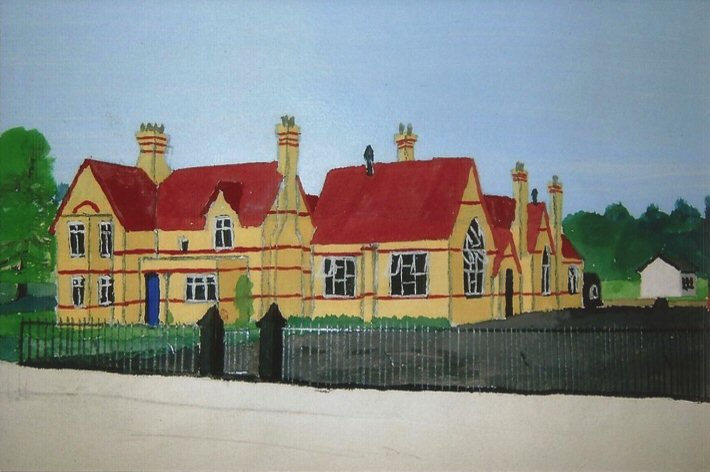 |
| Ivan and I went through the classes of Miss Brown, Mr Ashby,
Mr Graves -who then left and was replaced by Mrs Lovering who
wielded a mean plimsoll, and finally two years with Mr Johnson
in J4.
If you want to know why Ivan, I and a few others spent two years in J4, read it up in the Memoirs of a Moggy Rat. But this was my salvation; one of my J4 reports reads “Gwyn is inclined to play about, and not get down to serious work”. |
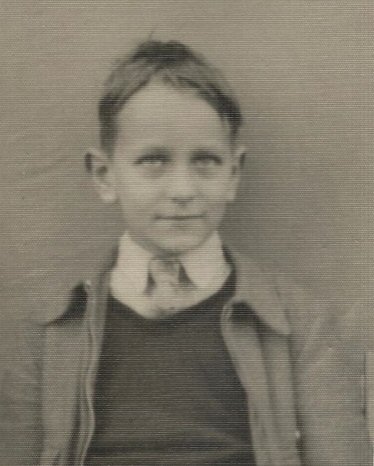 |
| On summer Sundays, we would catch the train for a day at Hunstanton, and I thought the railway down the pier very wonderful. | 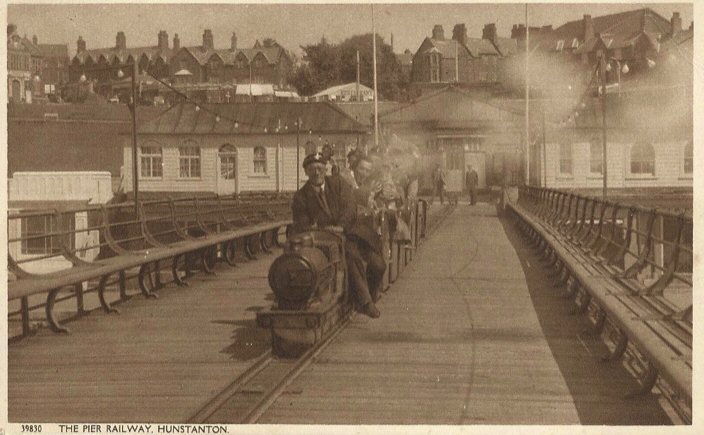 |
| In February 1950, father bought my first bike from Mr Summerscales, and if applying inflation since, I wonder what such a bike would cost today. | 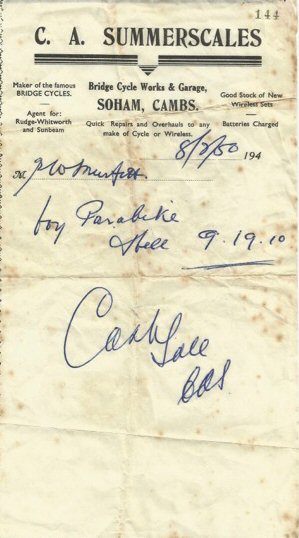 |
| On Whit Sunday 1953, aged 8, we cycled from Soham to Castle
Rising, where we visited the castle - photo on the left - then
across to Wisbech for bed and breakfast at granny’s, before
cycling back to Soham in time for the Whit Monday parade. The
Daily Mirror published my photo, and claimed I had
cycled 90 miles in one day.
The right-hand photo is the last one with the bike before taking it back to Summerscales for re-cycling. |
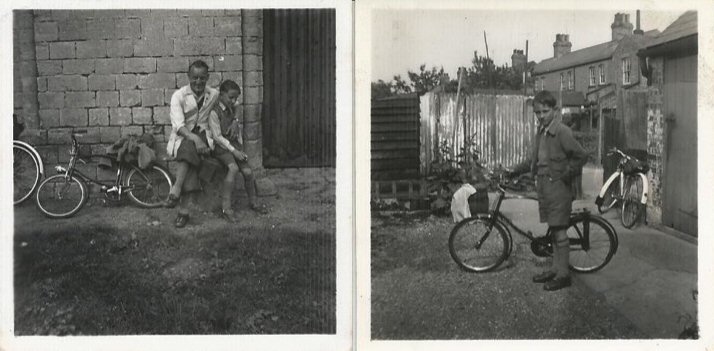 |
In the 1950s, Murfet’s installed a new dough machine. I used to gaze at the maker’s plate “Becketts, Fir St., Heywood, Lancs”;
Little did I think that living only 50 yards away was my future wife. It’s a small world.
| This is Jack Murfet’s youngest son, my uncle Doug.
In the 50’s he took up magic as a hobby, and started sending me tricks as presents. He eventually taught Tommy Cooper, and invented tricks. |
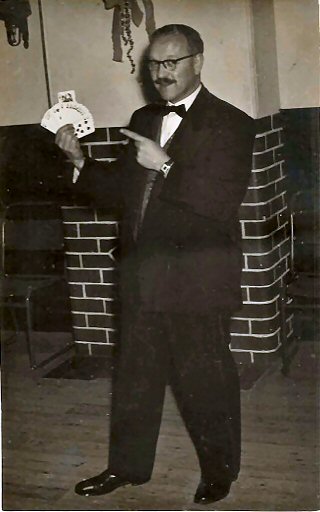 |
| 1956 saw my arrival at SGS (also from the backscene).
My first full day started with assembly, the theme being “Courage”. “Quit ye like men, be strong” - opening sentence; “through endeavour, failure, danger” - the hymn, and Mr Armitage read the prayer “O God, who knowest us to be set in the midst of so many and great dangers”. The first three lessons were: Maths with Mr Lawrance, Latin with Mr Saunders - and French with Mr Riley, who said “Uhhh, I know your father!” (we delivered bread to the Rileys). |
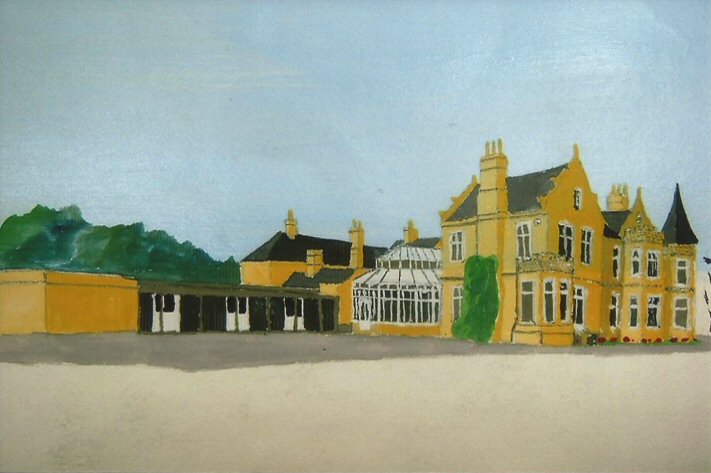 |
| Although my father had only gone to the Shade, he was a
great fan of Frank Richards, and his Greyfriars and
Billy Bunter stories, and we have a pile of letters
and Xmas cards from Frank Richards.
Here is one we received in my first term. |
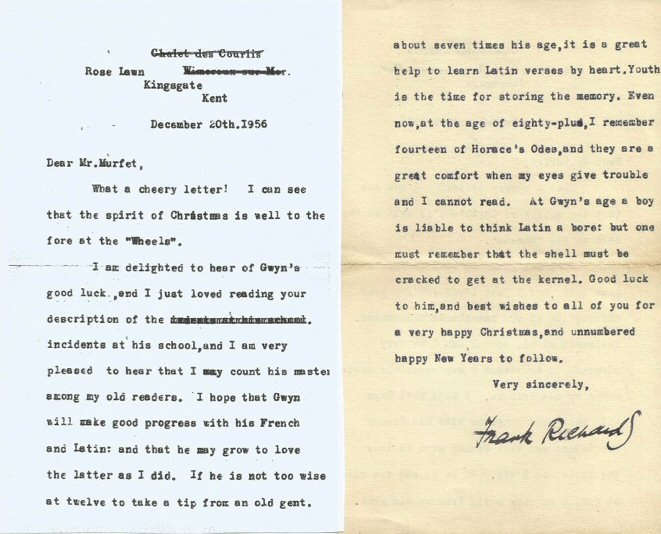 |
| After only 3 weeks in Tassell’s football team, I let the
ball past whilst playing full-back, and the other team scored.
I was busy watching an old Great Eastern E4 (now in York Railway Museum) steam across the Horse Fen Crossing. The rest of my school career was in the Remnants - which is
why my kit is still in wearable condition! |
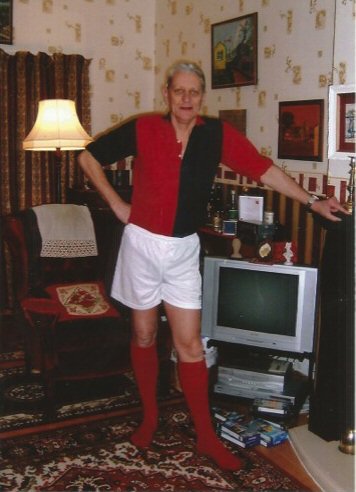 |
| I did not shine at woodwork, but I do wonder how many of these egg holders are still being used? As for the tray, Mr Tabraham asked whether I was planning to keep chickens in the joints! | 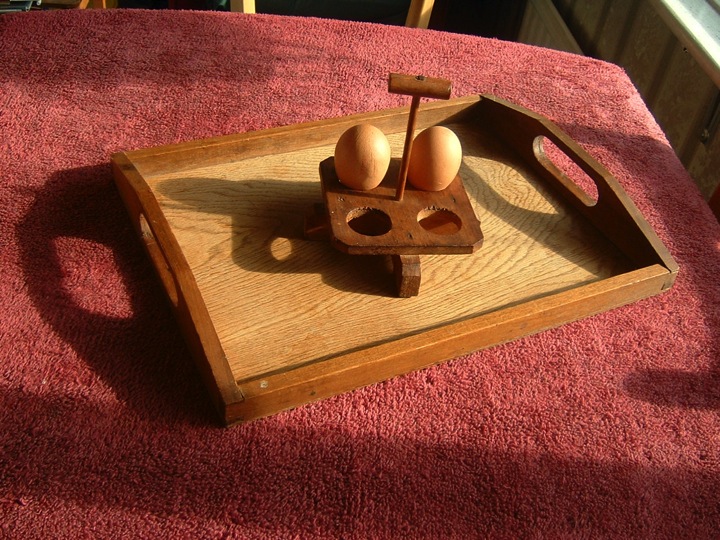 |
Ah, the Heavy Roller, over near the tractor shed ....
I think it was the Summer term in the 4th year. About ten of us had sick notes, and were excused playing cricket, so Mr Taylor set us to work with the heavy roller rolling the cricket square for Saturday’s match. If you remember, it was about 3 feet in diameter, 8 feet across and with heavy shafts for pulling by a horse.
I realised it had a bung, and was full of water. We let the water out - it was much easier to push!
After nearly an hour, Mr Taylor came across, and realised something was wrong. “My word, who’s let the b.... water out of the b... roller?”
| Following good O Level results, Robert Powell and I left in
July ’61 and started on the railway.
This photo is actually out of sequence and is October 1962. You had to work 12 months before getting a holiday. We went to stay with Uncle Doug at Kington; he had his own bar, and we both discovered cigars. |
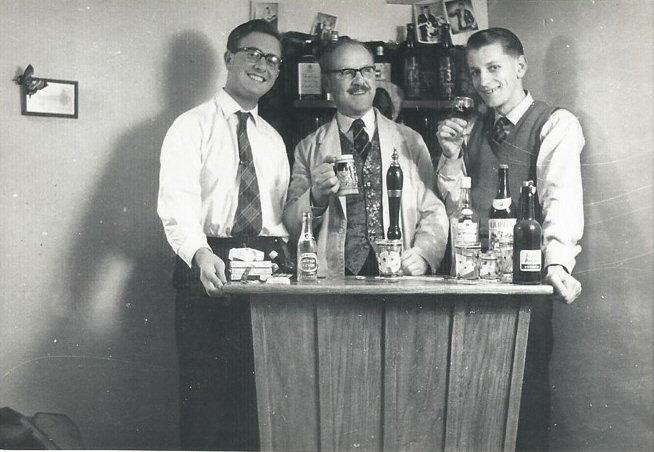 |
In October 1961, was told to report to the Station Master at Ely, and was taken to the booking office, where I met Ken Ball the Chief Clerk, and was told I would be working with Reg Black in the parcels office. In the booking office were Stan Harley and Tony Payton.
| Tony and I used to chuckle over poor old Reg Black, who had
started at Ely parcels in 1913, and was still sitting on the
same high stool at the same high desk using the same old glass
Great Eastern inkwell.
Little did either of us think that 50 years on, Tony would be honoured with his own plaque in the booking hall. When I consider the sheer number of changes Tony has put up with in that time, I take my hat off to him. There was one aspect of passenger working with which Tony had great difficulty - the Lost Property Register - you could always tell a Payton entry: - “One blue lady’s umbrella”. The only "blue ladies" we had, were on the 6.25pm to Shippea Hill on a Friday evening where they plied their trade at the local air bases. - “One pair of grey gentleman’s trousers”. Did the gentleman go grey before he lost his trousers or after? |
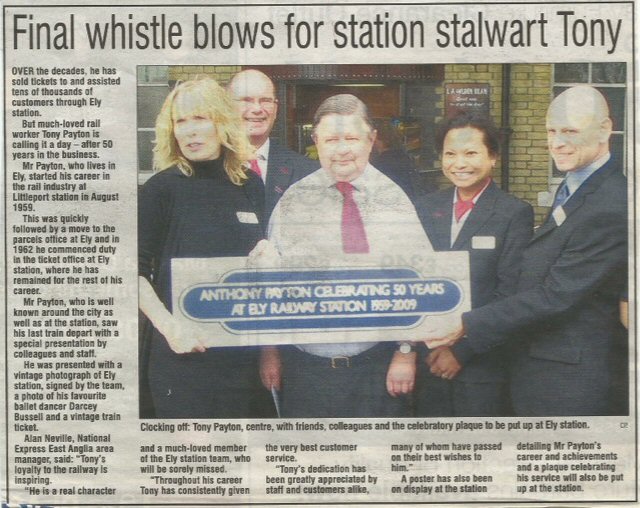 |
| You might have assumed Reg would have produced the most
wonderful copper -plate handwriting - but you would be very
far from the mark.
How the delivery drivers read it, I do not know. |
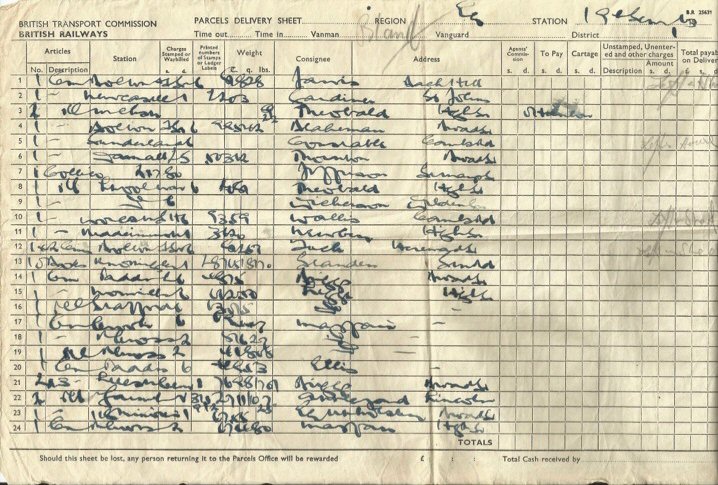 |
| Here we see Ken Ball sheeting parcels for delivery after Reg
had retired.
Parcels traffic was very heavy, in every sense. Inwards - vast quantities of Mail Order traffic - all the big stuff from catalogues. The High Street was under threat long before Amazon. Outwards traffic huge amounts of agricultural spares from Standens, especially during the beet season : enormous consignments of day old chicks from the local hatcheries of Fairburns, and Sykes - up to 250 boxes in a single consignment were quite normal. Every box had to have a serially numbered label, and the number of labels drawn had to balance with the consignment notes at the end of the day. |
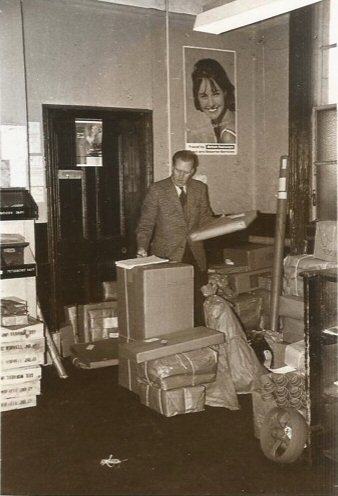 |
Les Dyer, I think from Streatham, bred rabbits, not as pets but for school biology classes. He should have used returnable wooden boxes, but he used the large cardboard boxes tobacco companies sent cigarettes to tobacconists’ - but with air holes and tied with string for a handle. One midday, he brought three rabbits in one box, bound for York. These were charged and sent on the 12.25 diesel train to Birmingham with transhipment at March into the Lowestoft/York which followed from Ely North junction.
Unfortunately, Les had given them too much to drink, and when the guard came to lift the box, the bottom fell out, and the rabbits made good their escape inside the train. Both trains were badly delayed, not by leaves, but by rabbits!
|
In March 1962, Stan Harley moved to Great Eastern House, Cambridge, and I took his place in the booking office. Ken’s first words that morning were “Through this window, passengers can see your face and your hands. Keep your hair brushed and your finger nails clean!” I soon learnt the most frequently asked question was “Has the next train to Cambridge gone yet?” Think about that one! The usual answer was "No madam, but you have missed the previous one". The ticket rack on the left held blank cards, and ordinary singles; the one on the right, special cheap day, day excursions, and ordinary returns. Another similar rack, behind the camera, held Privilege tickets and Force’s Leave and Duty tickets. With the RAF hospital in Ely, we issued many forces’ tickets. Forces Leave fares were 5/7ths of the ordinary fares and we were still in £sd. Think about working that lot out! |
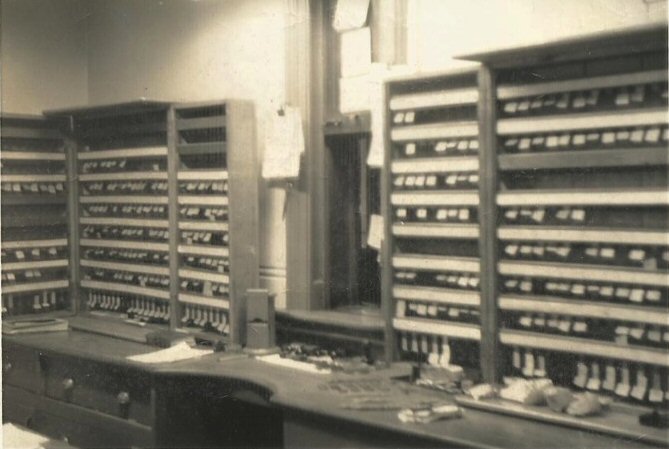 |
| Here we see Ken Ball at work. Not a computer/monitor, not
even a type-writer in sight: everything was hand-written.
Our most modern piece of equipment was a “national” telephone ie GPO; still referred to by some as “the speaking instrument”. Most communication between stations was by wire, using Morse code on the single needle telegraph. You can see how things changed in Tony’s 50 years. |
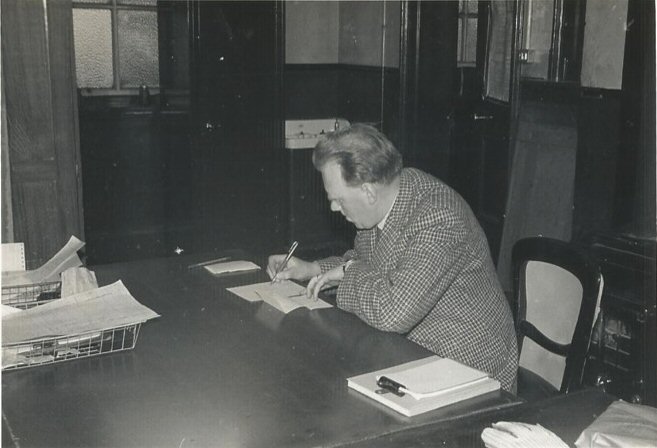 |
| The King’s School still used LNER luggage labels at the
start of each term, and this one happened to fall off in my
hand.
It belonged to Alan Yentob. |
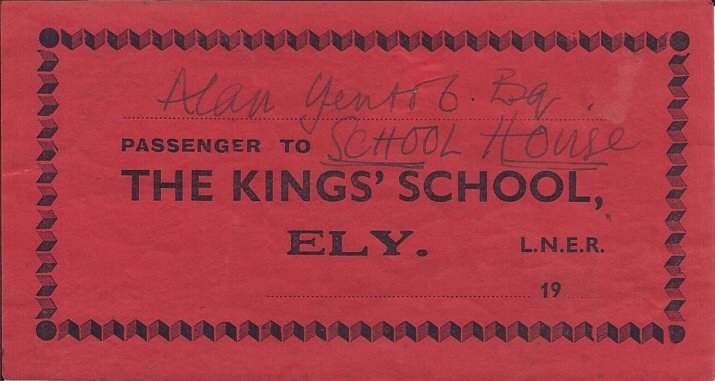 |
We had a number of characters ....
The elderly gentleman who used code to ask for tickets: “10 Woodbine=single Cambridge; 20 Players=Day Return”. Great fun, but not in the rush hour!
Rosie Lee the chiropodist, who on Mondays went to Downham Market and always wanted one 2/- piece in her change to pay her surgery rent.
Then there was Meg Salmons, the Ladies’ Waiting Room attendant who sold us cups of tea for a penny at 9.30am - gave a different meaning to “spending a penny”. However, she also had to sweep the office every morning immediately after opening at 6.30am. She swept with great vigour - all the dust went over her head and settled behind her; she never swept anything up, and the air afterwards was acrid.
Meg also had an invalid husband, and every so often she would say: “I thought I had lost my poor old Bert last night. ‘I’m going Meg, I’m going’, I said to him ‘you can’t go now Bert, your club money’s due next week’. That pulled him round; it always does. He won’t go if his club money’s due!”
In May 1965, I moved to the Eastern Region General Manager’s Passenger Movements, Current Performance Passenger Section at Liverpool St. Here we dealt with train delays and public complaints relating to express trains over the whole Eastern Region and also arrangements for the Royal Train.
|
It is not generally realised, but even when she travelled on the full Royal Train, Her Majesty still needed a ticket, and it was my job to obtain it in advance and have it sent to Buckingham Palace. We also printed cards for her use in the Royal Saloon. The one on the left when the saloon was attached to an ordinary service from Lynn, and the other for the full train from Wolferton. In Christmas 1966, I was Assistant to the Royal Inspector, and it was my job, once the empty stock was in platform 10 and the two diesel engines attached, to measure from the buffers of the leading engine to the centre of the saloon door. This was then wired to the Station Master at King’s Lynn who could get the red carpet in the right place. |
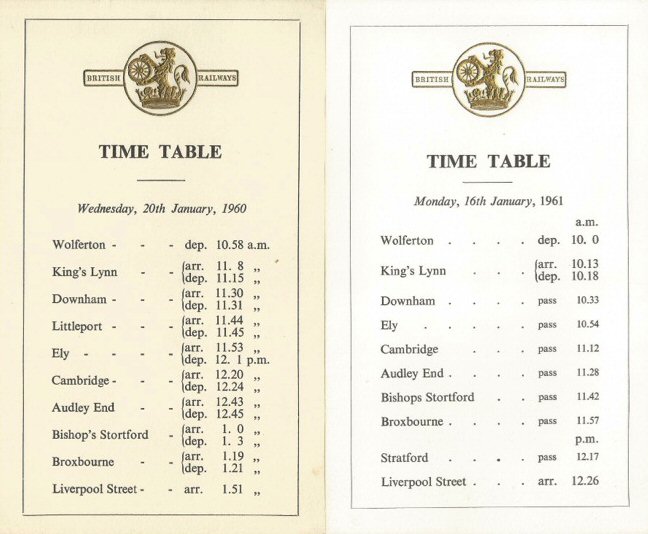 |
| The biggest source of complaints and train delays in the
winter, were due to heating failures. In steam days, all
coaches were steam heated from the engine boiler.
When diesels came in, the unfortunate decision was taken to retain steam heating and fit diesels with small oil fired boilers. Perfectly OK if stationary, but in traffic, the vibration caused sooting up, the flame would go out. No steam, no heat, and disgruntled passengers. When the London Midland electrified Manchester/Euston, we borrowed a set of their electrically heated stock. As there was not room for another generator in the loco body, it meant taking power from the traction motor’s generator for heating. Could we heat a full train, and crucially, still maintain our 100 mph schedules? Deltic D9007, Pinza, was chosen, and I was one of those on board, keeping records of temperature and performance. Everything was successful, and electric train heating became the norm. |
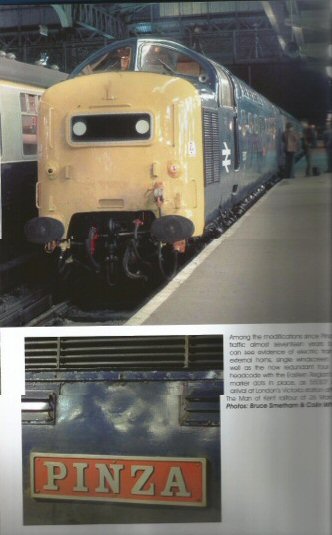 |
At the start of 1967, we learnt we were to merge with the North Eastern Region and the new HQ to be in York, and I started to wonder whether my time with BR was coming to an end. One Saturday, I asked to see Mr Armitage, who always thought I should have been a teacher. He realised my lack of A levels was a hindrance and suggested I became what is now known as a TA - Teacher’s Assistant, to get experience in a classroom and time for further study. I was already taking a Lay Reader’s course in theology.
I had an interview at a certain Secondary Modern the other side of Ely, but when the head realised I was ex-Grammar School, it was clear it wasn’t going anywhere.
One Sunday, a few weeks later at St Andrew’s, Mr Armitage was counting the collection and asked whether I had done anything about teaching. Norman Sykes, the organist, and careers teacher at The Village College, was passing through the vestry and asked what it was about. “Come to Evensong, we’ll go to the Red Lion afterwards, and see what we can do”.
| Things moved rapidly, and September 1967, on the strength of
the Reader’s Course, found me at St
John’s College of Education in York, studying
main course theology, and Middle School Education. In those
days I was lucky enough to have a student loan, not a student
debt!
About the only photo of me during these years is in the men’s chorus of The Mikado. |
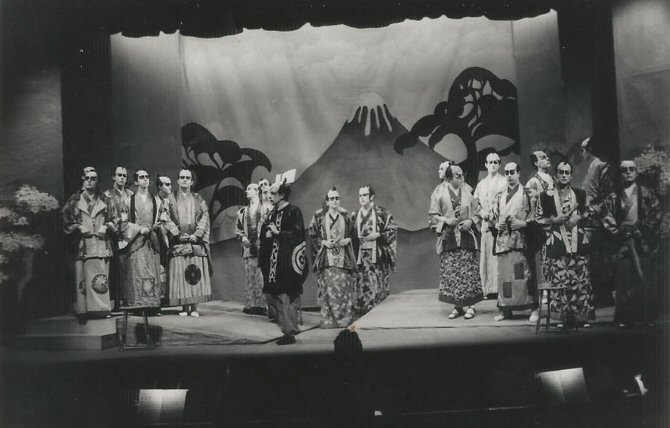 |
For many years, Grandfather Jack had been the tenor ringer at St Andrew’s, and so I joined the college bell ringers’ society and learnt to ring. Fateful decision! The following September, we ringers organised a coffee evening for “freshers”, and I was totally smitten by a gorgeous 18 year old who had been a ringer at Heywood. On 13 October, I invited her round for a coffee; it would have been the previous week, but Flying Scotsman had travelled to York that Sunday! We were engaged on 5 December, and married at Heywood as I left college.
In my 3rd year a new chaplain and his wife arrived. She had been a bell ringer, so Maureen and I took her with us ringing at Bishopthorpe. Here we discovered I had been selling her husband cheap day tickets to March on a Thursday evening whilst they were courting. It’s a small world!
In 1967, the college was in the forefront with technology and had its own TV studios and CCTV system. They also went out filming, and used one school in particular, Airedale Junior School, Castleford, which was described as being in the most socially deprived area in South and South West Yorkshire. Here the head teacher’s wife, Mrs “P”, had worked apparent wonders in language development with her class, which was also used by BBC and ITV whenever they wanted film of school children.
Guess who was given a job at Airedale by West Yorkshire LEA? You’ve got it, and I quickly discovered everything we had seen in college was a charade and travesty of the highest order. We will draw the curtain over this shameful episode. But, our youngest daughter trained as a chef, eventually went out to the French Alps working for a Ski Company, fell madly in love with the young on-site manager and married three years ago. Where did he go to school? Yes, Airedale Middle School, albeit 20 yrs after I had left. It’s a small world!
Fortunately, I was only there a year, as I had already been accepted for ordination training, so in August 1971, we moved to Lincoln, and I started at Lincoln Theological College, which with a Warden and the unfortunate title of “The Bishop’s Hostel” made it sound like a home for naughty boys! Chad Varah, founder of The Samaritans, was a Lincoln man, and served his title as curate at St John’s Barrow Island, where since retirement, Maureen and I have sung in the choir. It’s a small world!
Richard Chartres, present Bishop of London, studied alongside me, attending the same lectures and tutorials, but our paths have diverged since!
| I was made Deacon in York Minster June 1974, by Donald
Coggan, and a year later, as he had gone to Canterbury, was
ordained priest by Stuart Blanche.
I served my title as curate of Scalby, Ravenscar & Staintondale on the Yorkshire coast just north of Scarborough. Scalby maintained its traditional village atmosphere, although many inhabitants were retired business people from West Yorkshire. The parish included an outer suburb of Scarborough, Newby, where we discovered the local Primary School Head teacher, Mr Wheeler, had been head at Soham Shade School. |
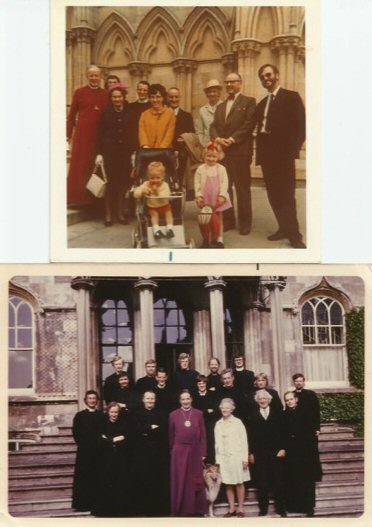 |
Famous people? You may remember a TV programme in 1976 about Eric Fenby. Delius, the composer, was blind, and needed an amanuensis, a scribe, to write down the music as he dictated : this was Eric Fenby. Eric’s mother lived in the parish, and died a few weeks later, so I came to meet the great man and take the funeral. I conducted - Delius’ amanuensis’ mothers’ funeral. That really is clutching at straws!
The two other parishes of Ravenscar & Staintondale consisted of traditional Yorkshire country farmers, salt of the earth, and such as you see in All Creatures Great and Small and Heartbeat.
In Staintondale, were four siblings living together - two brothers, two sisters all in their late 70s and 80s. Early one afternoon, the undertaker rang; one of the brothers had died over lunch - would I go up? I arrived at about 3pm, to find the remaining brother staring at the fire, but the two sisters, aprons on, sleeves rolled up, and trays of sausage rolls, cakes and buns already on the table, and more awaiting the oven. When I expressed surprise, was told “Ehh, nay lad. Minute he breathed ‘is last, we started baking. It’ll be a reet big do tha’ knaws”.
At my 2nd Harvest Festival, I was asked to preach for sung Evensong at Ravenscar, and wondered how I might get their attention. I remembered one of my old magic tricks Uncle Doug had sent me when I was about 8.
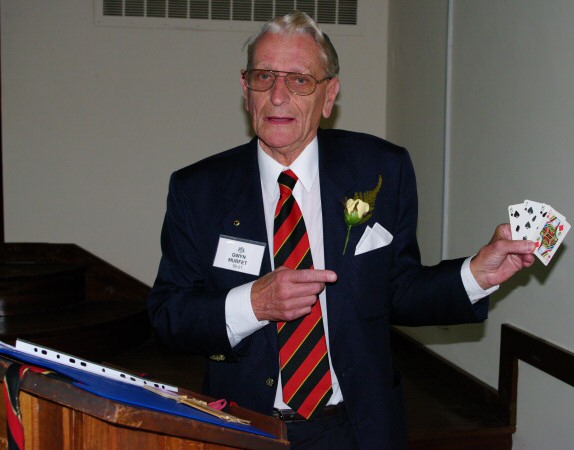
Here Gwyn performed the Multiplying Card trick
| In December 1977 I was asked to become Rector of South
Milford between Leeds and Selby. On the first Sunday I
discovered that back in 1962 I had been selling reduced rate
season tickets to one of the congregation. You can’t escape a
good booking clerk!
My parish contained Europe’s largest Construction site, namely the Selby coalfield, the lengthy drift mine emerging in South Milford. It was to produce coal for at least the whole of the 21st Century. I understand it is already mothballed! You may not know this, but 1982/3, it was seriously believed by the government, war was imminent with Russia, and appointed a minister for war based on Selby. One afternoon, this guy came to see me. From the Rectory we could see Ferrybridge, Eggborough and Drax power stations. He said it was expected Russia’s initial strike would be a nuclear bomb on Eggborough, which would knock out all three power stations, and the new coal mine, in one go. He then told me that in such an event, the Rectory would be the only building in the parish to have a telephone which was for emergencies only! Would I have a Rectory to go round it, I wondered? |
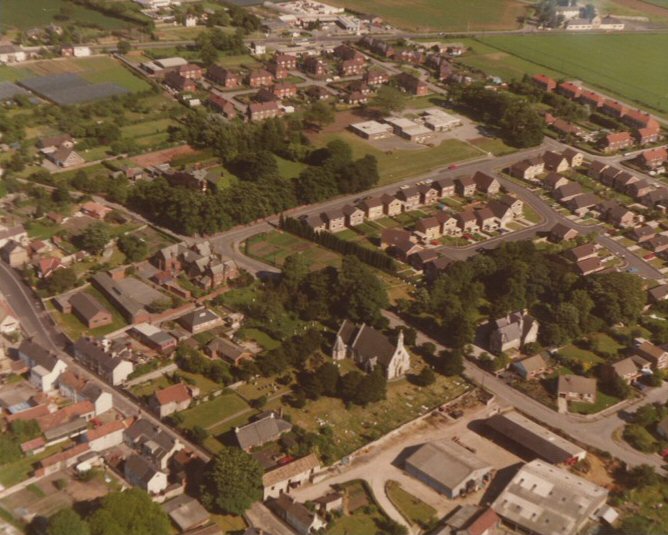 |
| In April 1984, I was inducted as Vicar of Kirkby in Furness,
South Cumbria at the north end of the Duddon estuary.
I returned to Soham in 1985 to lead the prayers at Mr Ford’s funeral. Any famous people in Kirkby in Furness? Well in 21 years, I baptized Moses, prepared Adam for confirmation, took the wedding of a girl surnamed Samson, and buried not only Isaac, but also Plato. Of others, there was the funeral of the man who worked alongside Frank Whittle developing the jet engine; the funeral of another who had helped design the Sunderland flying boats; and the funeral of Denny Dennis, the singer, who was on the radio most nights in the 30s-50s, who recorded over 1000 songs on 78s, and whose records are now available on CDs. |
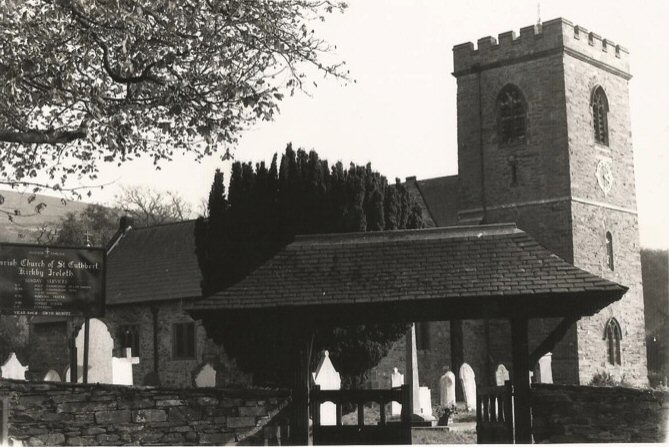 |
| This is the view from our bedroom window. We moved my
parents from Soham in November 1986, and father died two
months later.
Uncle Doug came to visit and see the headstone in the October, and as it was Harvest, I blew the dust off the old Ravenscar sermon. He told me about The Fellowship of Christian Magicians; I attended my first Gospel conjuring conference the following year, and learnt a great deal. This is one of Doug’s inventions, which I use to illustrate 1 Peter 5 “Brethren, be sober, be vigilant...” [here Gwyn performed Potty Poker]. Gospel Magic has served me well over the years since, especially with school assemblies. |
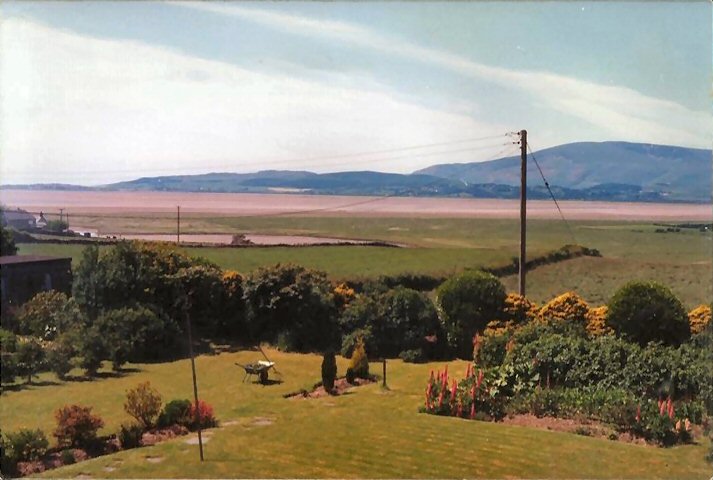 |
| With permission from English Heritage, we took the Sunday morning service to Furness Abbey, and the Archdeacon preached. | 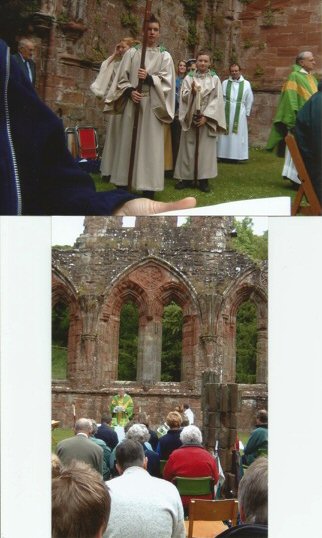 |
| In 2002, I trained as a guard on the Ravenglass
& Eskdale Railway; we get some interesting visitors!
One family from London bought a family weekly runabout (about £100) but went home after two days and returned the ticket demanding their money back. Why had they gone home? They were "disgusted by the lavatorial habits of the cows and sheep”! [Gwyn guarding Ivan Whymer] |
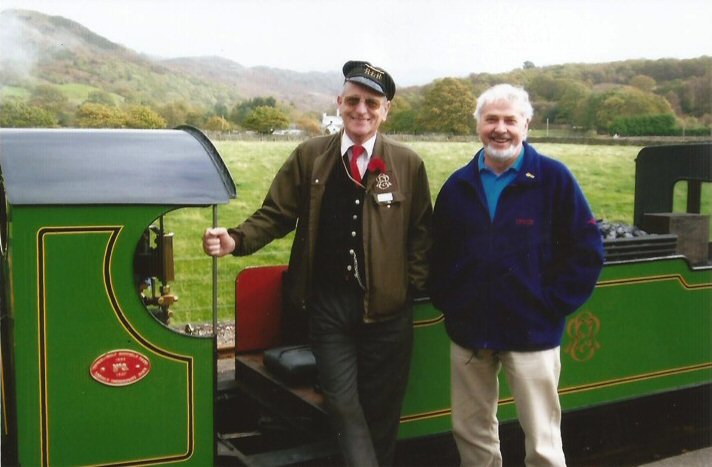 |
| The following year I was appointed Station Master, Irton
Road. I had always wanted to be a Station Master, so one wheel
has turned full circle.
Two years ago, a chap and his wife alighted there; he gazed at my name label and asked where I came from. On telling him, he said we had been at school together: it was Dave Baumber - we had started in IT in 1956, and left in July 1961 |
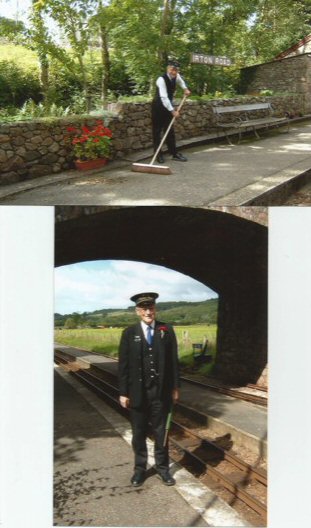 |
| The railway has enabled me to meet Pete Waterman, and Princess Alexandra. | 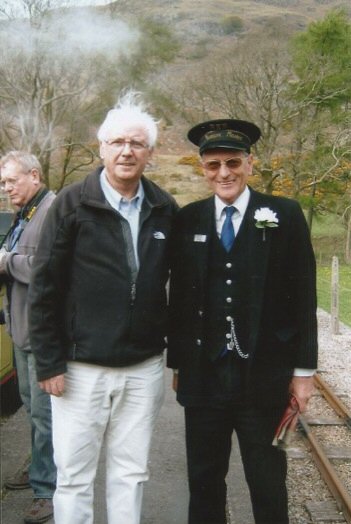 |
| At the end of this month, for Hallow'een I shall be the ghostly Station Master of Irton Road - I work on the principle if I am frightening the children on the railway, they are not knocking on people's doors. | 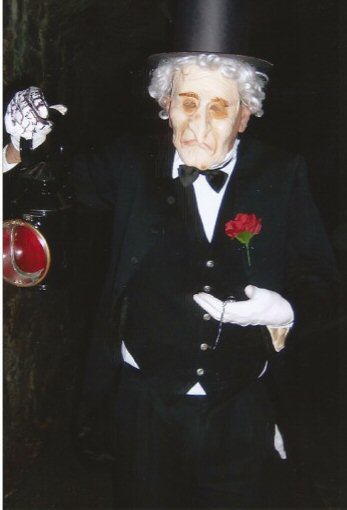 |
On 20th February 2005 I collapsed whilst taking morning service and neither Maureen nor a retired nurse from the hospice could find a pulse. Following a doctor’s report, the Church Pension Board decided I ought retire early and I finished in November 2005.
| Maureen was working as a Special Needs Tutor at Barrow 6th
Form College, so we found a house on Walney Island, just off
Barrow in Furness.
Walney is 12 miles long and 1 mile wide, and is also a Land of great skies and measureless horizons. |
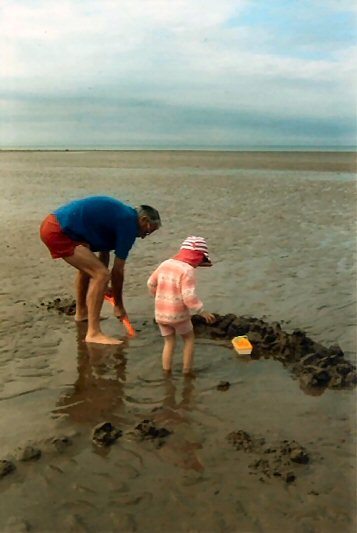 |
| Between us and the mainland, is Barrow Island, which houses
what is now BAE Systems Shipbuilding and Engineering. This
shows the Dock Hall where the Trident submarines are made, and
here we see the first of the Astute class.
These are huge, and the massive sections of hull are manufactured a quarter of a mile away and brought on a huge transporter to the Hall to be made into submarines. On one such move, they managed to demolish a bus shelter. Not many bus shelters are hit by a passing submarine! |
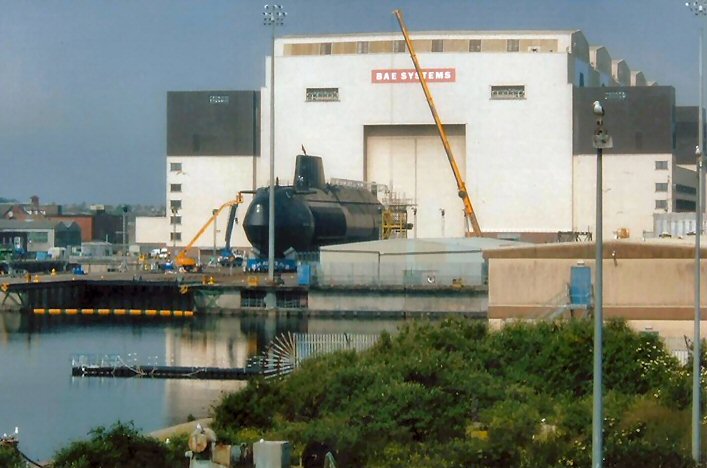 |
| As we live within a 2km radius of the Hall, when new nuclear subs “go critical” we all receive booklets on “what to do in a radiation emergency”. | 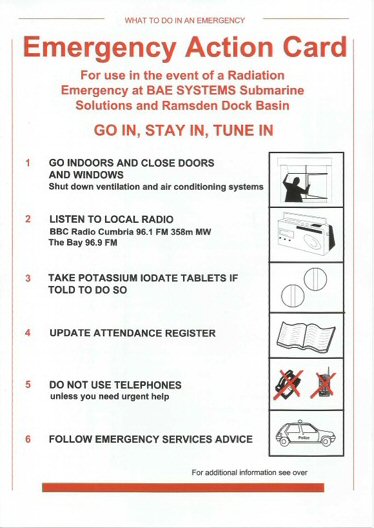 |
| I continue with Gospel Magic, my next talk is in three weeks time. | 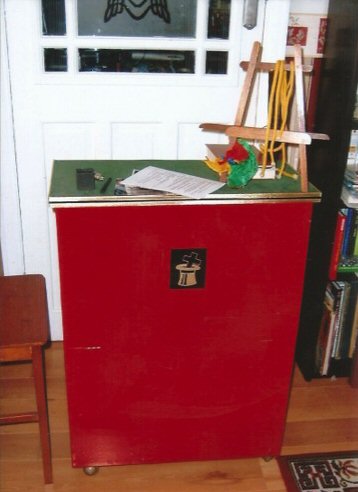 |
| .... and grandchildren love magic, especially this trick which produces sweets from fire! | 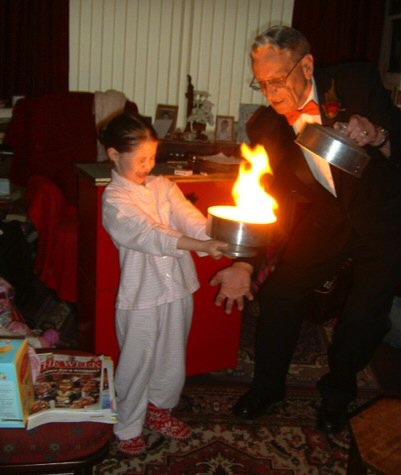 |
| I have a model railway, and yes, the Soham sign is an
original.
I paid 2/6 for it, and a similar one was sold recently for £2,500. |
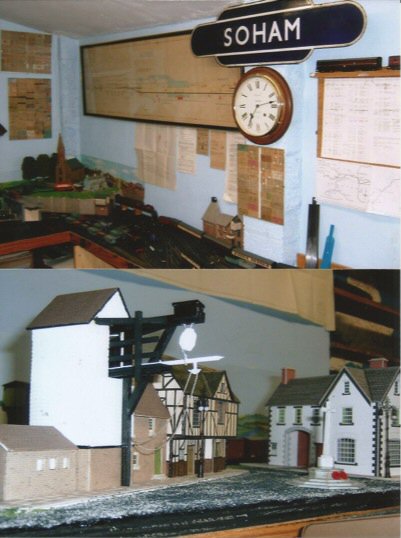 |
| Grandchildren love having a granddad on close terms with Father Xmas. | 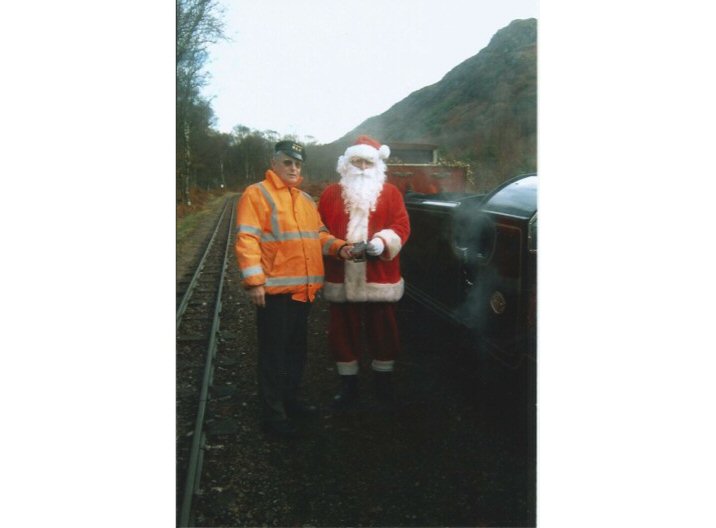 |
They all live away, but when they do come
and visit, enjoy time at Irton Road.
Here you see me training one of them to be a booking clerk, and as
platform staff.
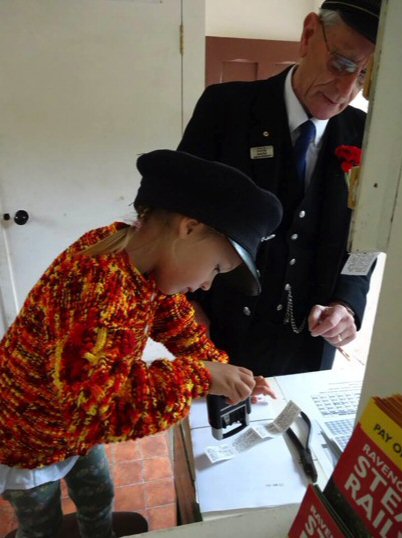 |
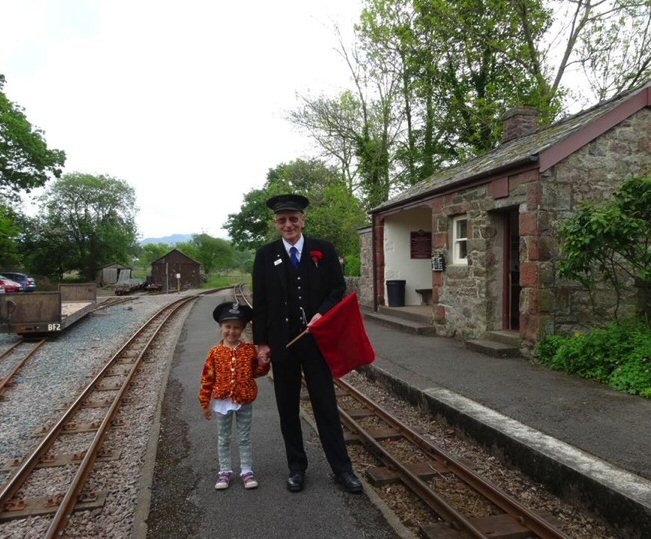 |
| I share an allotment, which provides good exercise and produce. | 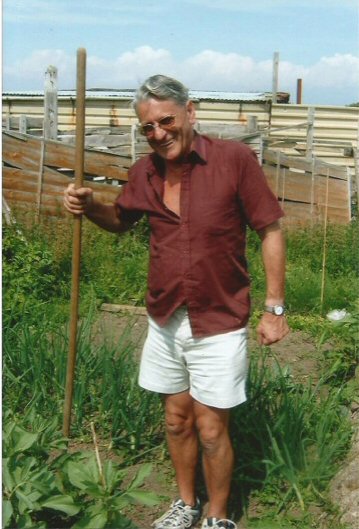 |
We have many lovely walks and tarns on Walney and enjoy beautiful sunsets.
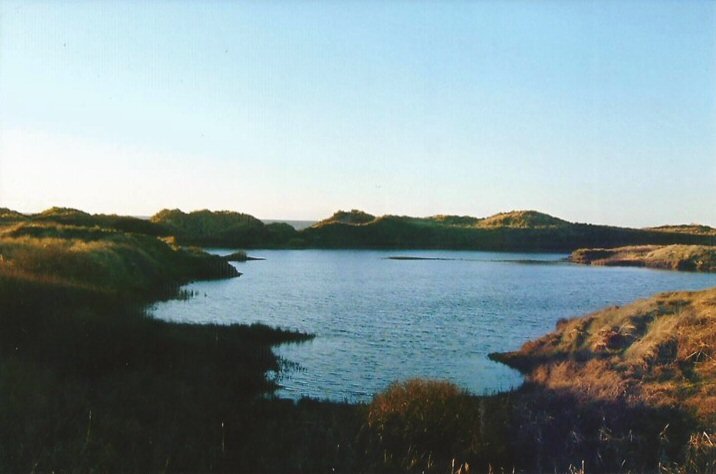
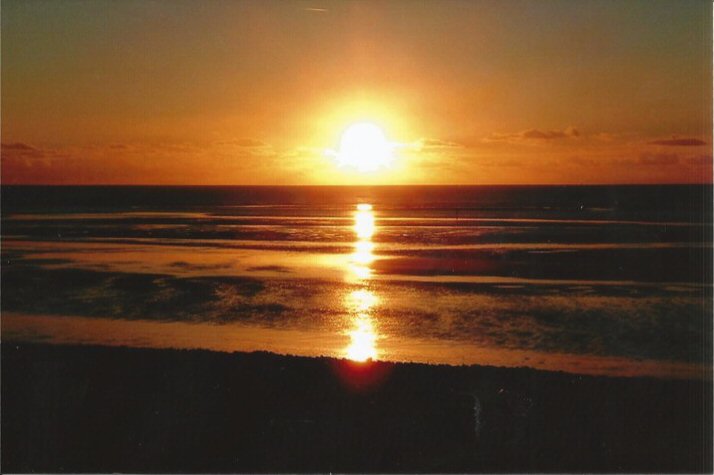
The talk was “SGS and beyond”... my undated headstone is already up in Kirkby churchyard, and I am hoping there is still some of “the beyond” to come.
I have never started a sermon with a text, but will finish with one now:
Ecclesiastes 8 v15 “I think we
should get as much out of life as we possibly can.
There is nothing better than to enjoy our food and drink and to have a
good time.”
[Ed - Gwyn's talk was much appreciated and warmly received.]
2014 Luncheon Report
Geoff Rouse writes: When we were boys Gwyn and I lived just around the corner from each other in Soham, him in The Butts and me in Mill Croft. On that memorable day at the start of the Autumn term 1956 we walked to school together on the start of a journey that was to shape our respective lives. I felt privileged to have been in 1T that first year when I learned a lot of common sense from R A Taylor, a first rate teacher as well a sportsman of some renown in his own right (still turning out for Cambs in Minor counties cricket at that time.)
I was not able to come this year, I would have liked to hear Gwyn's talk. Thank you for the photo Gwyn provided that time prevented him from using in his presentation. It was taken at one of my birthday parties in the garden of 14 Mill Croft. I would say I was 4 or 5 at the time, probably 5 which would put it at 21st March 1950. Gwyn is the one on the right wearing a beret and, needless to say, I'm the one in the wheelbarrow!
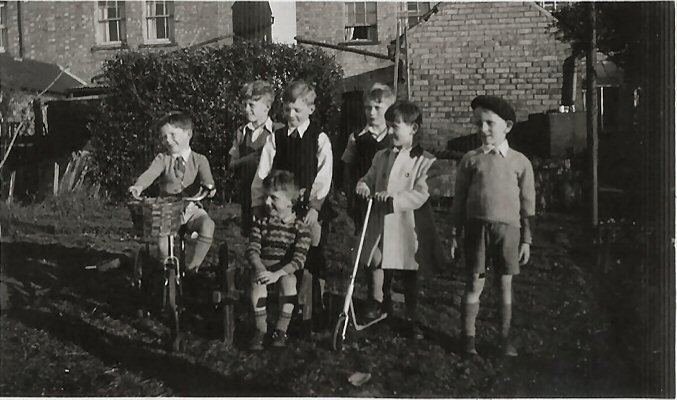
page created 13 Oct 2014: last updated 24 Oct 14:
reformatted 7 Feb 19
Images: unless otherwise stated provided by Gwyn Murfet
Note: the links have been added by the editor and no responsibility for
the accuracy or otherwise of these can be attributed to the editor or to
Gwyn Murfet.
Please contact the editor if you can add to this page.